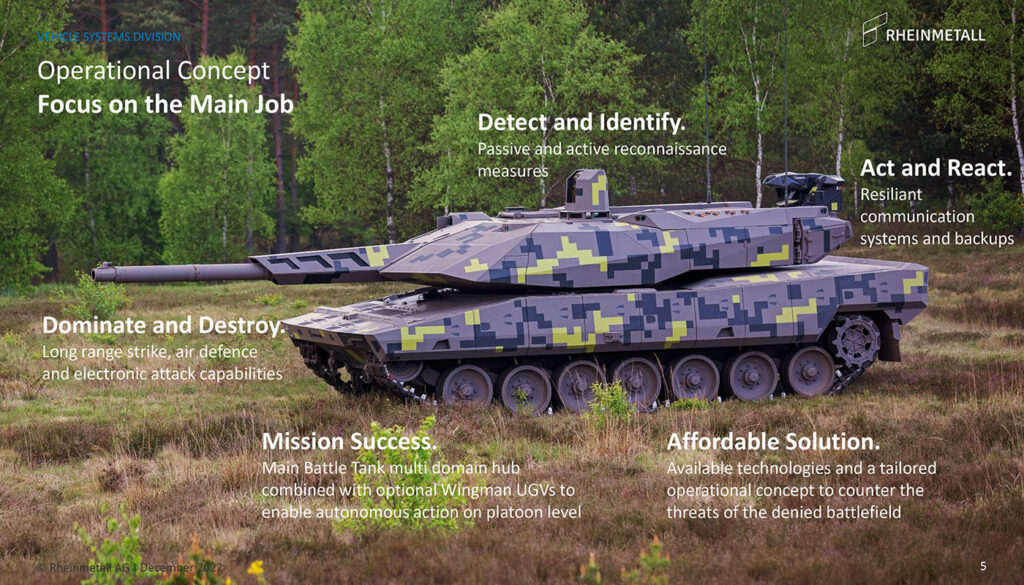
KMW called the @RheinmetallAG's #KF51 Panther a "3D power point project" & "a funny car" designed around a new gun. While it has not seen prodution yet, is at least the concept behind it sound?
At the recent Rheinmetall Defence Talks 2022, further details on KF51 were shared.
At the recent Rheinmetall Defence Talks 2022, further details on KF51 were shared.

Unfortunately the presentations have not been made public, which means we have to rely on media coverage of the event to gain new informations. I've been trying to find articles on it, but at the moment I've only found an article on @DefenceReviewGr.
defencereview.gr/ellinikos-stra…
defencereview.gr/ellinikos-stra…
Luckily this article includes a few of the original slides regarding the #KF51 Panther's concept and capabilities. In its core, the KF51 is a conventional MBT with focus on use of new technologies while remaining affordable. An evolution rather than a revolution. 

Networked operations are a key addition provided by the #KF51 over older MBTs. The Panther's crew can hand over targets to other vehicles, start and control micro-UAVs, control UGVs and (when fitted with an attack UAV or HERO starter) engage targets behind the line-of-sight. 

The #Panther's FCS is designed to maximize the likelihood of being the first to detect the enemy, the first to fire & the first to hit. An AI-based Automated Target Acquisition, Classification, Tracking and Attack (ATTAC) system is integrated into the FCS. 

The commander's SEOSS-2's sight can be fitted with the MSSA (main sensor slaved armament) add-on to be turned into an RWS or with a counter-UAV radar to detect/track low-flying air threats.
A 4-10 kW HEL can also be installed to defeat micro-UAVs.

A 4-10 kW HEL can also be installed to defeat micro-UAVs.


The #KF51 isn fitted with 10 different camera modules (4 on hull, 6 on turret) for 360° surveillance, an upgraded EMES gunner's sight & SEOSS-2 sight for the commander. Additional sensors (laser warners, acoustic detection and a meteorological sensor) are mounted on the turret. 

The NATO Generic Vehicle Architecture (NGVA) is fully implemented and acts as the digital core of the KF51. The software is certified to common cyber security standards; it allows the use of on-board status analysis & test systems. Software also assists maintenance. 

A key focus of the #KF51 is improving survivability. This is done with polyvalent add-on armor having passive components capable of defeating mid - not medium - calibre rounds. The roof is protected against bomblets A mine protection kit is not installed as standard. 

Additional protection is provided by the hard kill StrikeShield active protection system against ATGMs, RPGs & APFSDS. There also is sensor triggered active armor. Together with the base armor, this should enable the KF51 to resist current anti-tank weapons (within frontal arc). 



In addition to the conventional armor, the upper hemisphere of the #KF51 #Panther is protected by a Top Attack Protection System (TAPS). The TAPS consist of the StrikeShield APS, the ROSY smoke screen system and a different (EW?) system mounted on the bustle against drone swarms. 



In terms of armament, the Panther was showcased with a 130 mm L52 gun (10-30 rounds depending on config), a 12.7 mm coaxial machine gun (1,250 ready rounds) and a Natter RWS (2,500 ready rounds of 7.62 mm ammo).
10 ready 130 mm rounds can be replaced with a 4-starter of HERO120.
10 ready 130 mm rounds can be replaced with a 4-starter of HERO120.

The autoloader reaches a minimum loading time of four seconds and a minimum feeding time of two seconds. In best case (i.e. the second round is already located in the feeding tray/arm), two shots can be fired within just three seconds time.
The Natter RWS is meant for defeating infantry and smaller drones. Instead of a 7.62 mm MG, a larger 12.7 mm HMG or a 40 mm HV grenade launcher (HK GMW, Mk 19, etc.) can be fitted instead.
• • •
Missing some Tweet in this thread? You can try to
force a refresh









